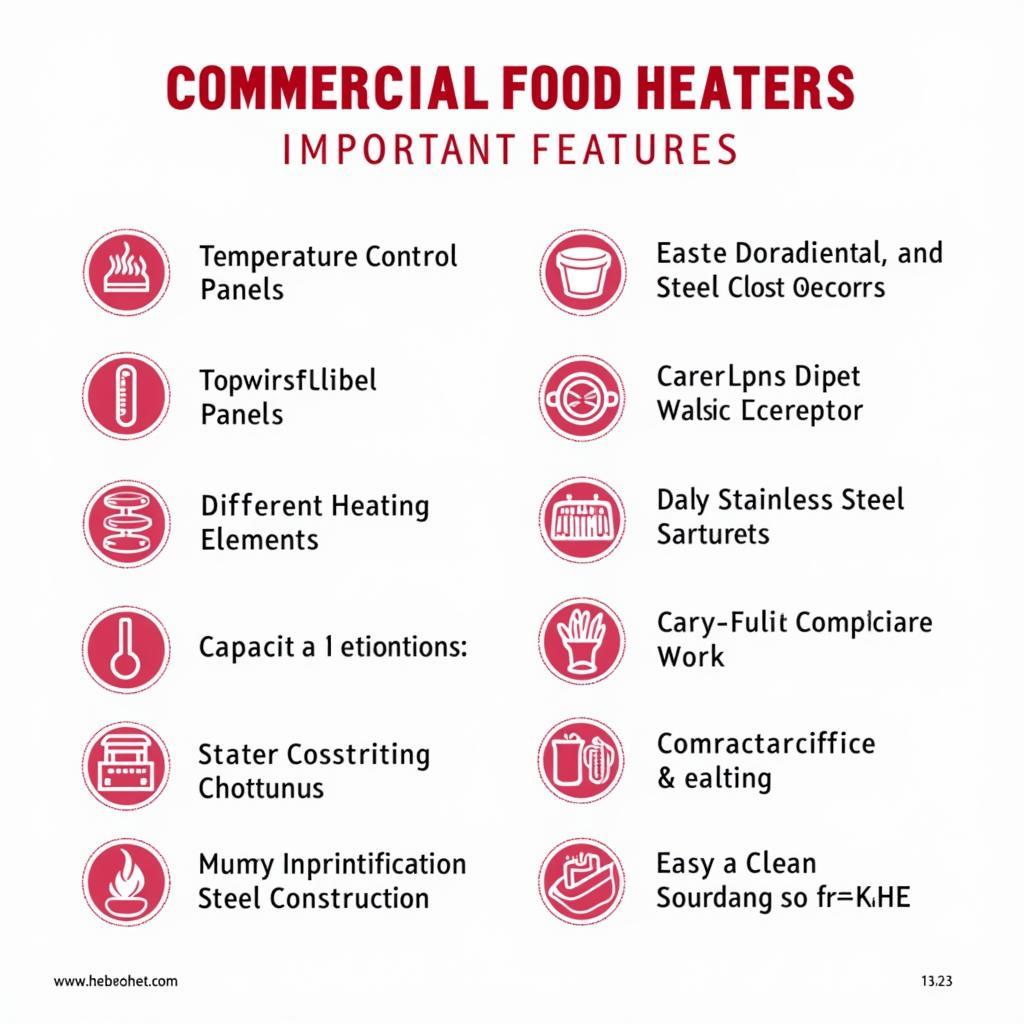Commercial Food Heaters are essential for any food service business, from restaurants and cafes to catering companies and hotels. They keep food at safe temperatures, enhance presentation, and improve overall customer satisfaction. Choosing the right one can be a daunting task, considering the numerous options available. This guide dives deep into the world of commercial food heaters, equipping you with the knowledge to make an informed decision.
Types of Commercial Food Heaters
Several types of commercial food heaters cater to specific needs and applications. Understanding these differences is crucial for selecting the ideal equipment for your business.
Dry Heat Food Warmers
Dry heat food warmers maintain food temperature without added moisture. They are excellent for items like bread rolls, pastries, and fried foods, preventing them from becoming soggy.
Wet Heat Food Warmers
Wet heat warmers, often called steam tables, use moist heat to keep food warm and retain moisture. They are ideal for soups, stews, and vegetables.
Heat Lamps
Heat lamps provide focused heat to keep prepared food at serving temperature. They are commonly used in buffet setups and carving stations.
Induction Food Warmers
Induction food warmers use electromagnetic fields to heat cookware directly, offering precise temperature control and energy efficiency. These are ideal for delicate sauces and precise temperature-sensitive dishes.
Factors to Consider When Purchasing a Commercial Food Heater
Choosing the right commercial food heater depends on various factors specific to your business operations.
Capacity
Consider the volume of food you need to keep warm at any given time. A high-volume establishment like a buffet requires larger capacity warmers than a small cafe. Are you looking to serve large quantities of pre-made items like at a sporting event? Or are you focusing on smaller, more intimate meals?
Temperature Control
Precise temperature control is critical for food safety and quality. Look for heaters with adjustable thermostats for different food types. Food warmers, like the food warmer nemco, offer a range of temperature control options to maintain optimal food quality.
Energy Efficiency
Energy-efficient models can significantly reduce operating costs. Consider features like insulated walls and energy-saving modes.
Ease of Cleaning
Easy-to-clean surfaces and removable components simplify maintenance and ensure hygiene standards. This is especially important for fast-paced environments where downtime is costly.
Mobility
Portable food warmers offer flexibility for catering events and mobile food service businesses. Consider whether a stationary unit or a mobile setup better suits your needs. Think about how you might transport food from a central kitchen using tools like an elevator for transporting food.
 Key Features of a Commercial Food Heater
Key Features of a Commercial Food Heater
What are the Benefits of Using a Commercial Food Heater?
Commercial food heaters provide numerous advantages for food service businesses.
- Maintain Food Safety: Keeping food at the correct temperature prevents bacterial growth and ensures food safety compliance.
- Enhance Food Quality: Proper warming preserves flavor, texture, and moisture, improving the overall dining experience.
- Improve Efficiency: Heated food is ready to serve, streamlining service and reducing customer wait times.
- Boost Sales: Appealing presentation encourages impulse purchases and increases customer satisfaction.
- Versatility: Different types of food heaters accommodate various food items, expanding menu options.
You may also need other equipment to complement your commercial food heater, such as plastic take out food containers for leftovers or quick meals.
Maintaining Your Commercial Food Heater
Regular maintenance extends the lifespan of your commercial food heater and ensures optimal performance.
- Clean regularly: Wipe down surfaces and remove food debris after each use to prevent build-up and maintain hygiene.
- Inspect components: Check heating elements, thermostats, and other parts for damage or malfunction.
- Calibrate thermostats: Ensure accurate temperature readings by calibrating thermostats periodically.
- Follow manufacturer’s instructions: Refer to the user manual for specific cleaning and maintenance recommendations.
For specialized food preservation needs, you might also consider investing in a lem food saver.
Conclusion
Investing in a commercial food heater is a crucial decision for any food service operation. Choosing the right type, considering key features, and implementing regular maintenance ensures food safety, enhances food quality, and contributes to a successful business. Consider the specific needs of your business and select a commercial food heater that meets those requirements to optimize your food service operation. Remember that a well-maintained commercial food heater is an investment in customer satisfaction and business success.
FAQs
- What is the ideal temperature for holding hot food?
- How often should I clean my commercial food heater?
- What are the different types of heating elements available?
- How can I improve the energy efficiency of my food heater?
- What are the safety precautions for using a commercial food heater?
- Where can I find replacement parts for my food warmer?
- What should I do if my food warmer malfunctions?
Looking for other food service solutions? Consider checking out our resources on military food mre for sale for unique catering options.
Need help with selecting the right commercial food heater for your needs? Contact us at Phone Number: 02437655121, Email: minacones@gmail.com Or visit us at: 3PGH+8R9, ĐT70A, thôn Trung, Bắc Từ Liêm, Hà Nội, Việt Nam. We have a 24/7 customer service team.